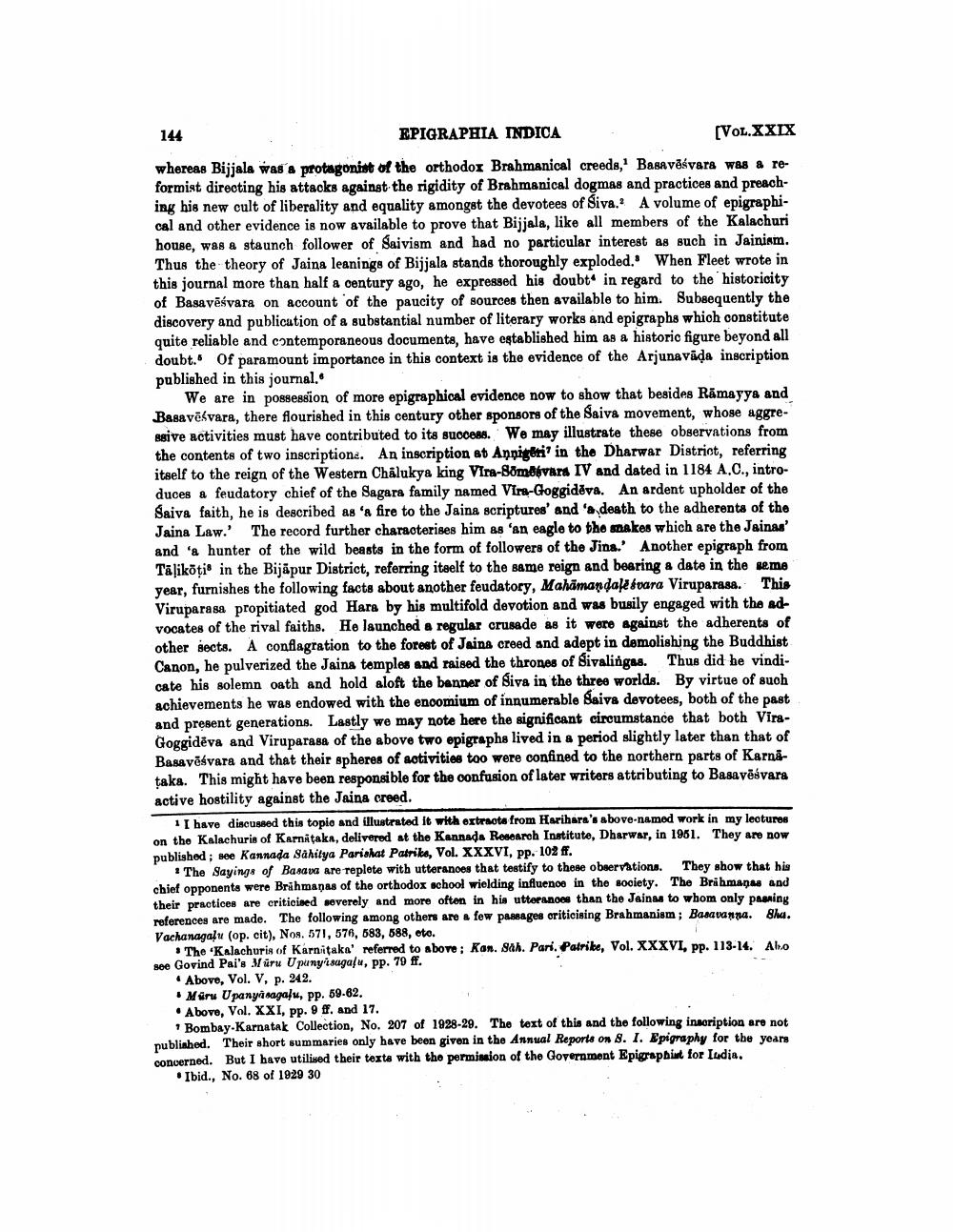________________
144
EPIGRAPHIA INDICA
(VOL.XXIX
whereas Bijjala wad's protagonist of the orthodox Brahmanical creeds, Basavēsvars was a reformist directing his attacks against the rigidity of Brahmanical dogmas and practices and preaching his new cult of liberality and equality amongst the devotees of Siva. A volume of epigraphical and other evidence is now available to prove that Bijjala, like all members of the Kalachuri house, was a staunch follower of Saivism and had no particular interest as such in Jainism. Thus the theory of Jaina leanings of Bijjala stands thoroughly exploded. When Fleet wrote in this journal more than half a century ago, he expressed his doubto in regard to the historicity of Basavēśvara on account of the paucity of sources then available to him. Subsequently the discovery and publicution of a substantial number of literary works and epigraphs which constitute quite reliable and contemporaneous documents, have established him as a historic figure beyond all doubt. Of paramount importance in this context is the evidence of the Arjunavāda inscription published in this journal.
We are in possession of more epigraphical evidence now to show that besides Rāmayya and Basavēśvara, there flourished in this century other sponsors of the Saiva movement, whose aggreasive activities must have contributed to its succes. We may illustrate these observations from the contents of two inscriptions. An inscription et Annigeti' in the Dharwar District, referring itself to the reign of the Western Chalukya king Vira-Bombovara IV and dated in 1184 A.C., introduces a feudatory chief of the Sagara family named Vira-Goggidēva. An ardent upholder of the Saiva faith, he is described as 'a fire to the Jaina scriptures' and 's death to the adherents of the Jaina Law. The record further characterises him as 'an eagle to the snakes which are the Jainas' and '& hunter of the wild beasts in the form of followers of the Jina.' Another epigraph from Tasiköti in the Bijapur District, referring itaelf to the same reign and bearing a date in the seme year, furnishes the following facts about another feudatory, Mahamandalesvara Viruparasa. This Viruparasa propitiated god Hara by his multifold devotion and was busily engaged with the ad vocates of the rival faiths. He launched a regular crusade as it were against the adherents of other sects. A conflagration to the forest of Jains creed and adept in demolishing the Buddhist Canon, he pulverized the Jaina tomples and raised the thrones of Sivalingas. Thus did he vindicate his solemn oath and hold aloft the banner of Siva in the three worlds. By virtue of such achievements he was endowed with the encomium of innumerable Saiva devotees, both of the past and present generations. Lastly we may note here the significant circumstance that both ViraGoggidēva and Viruparana of the above two epigraphs lived in a period slightly later than that of Basa vēsvara and that their spheres of activities too were confined to the northern parts of Karnataka. This might have been responsible for the confusion of later writers attributing to Basavēsvara active hostility against the Jains creed.
1 I have discussed this topio and illustrated it with extracts from Harihara's above-named work in my lectures on the Kalachuris of Karnataka, delivered at the Kannada Research Institute, Dharwar, in 1961. They are now published ; see Kannada Sahitya Parishat Patrike, Vol. XXXVI, pp. 102 ff.
· The Sayings of Basawa are replete with utteranoes that testify to these observations. They show that his chief opponents were Brahmaņas of the orthodox school wielding influence in the society. The Brahmaņas and their practices are criticised severely and more often in his utterance than the Jainas to whom only passing references are made. The following among others are a few passages oriticising Brahmanism; Basavanna. Bhu. Vachanagalu (op. cit), Nos. 571, 576, 583, 588, eto.
• The 'Kalachuris of Karnitaka' referred to above; kan. Sah. Pari. Patrike, Vol. XXXVI, pp. 113-14. Abo Hoe Govind Pai's Múru Upunyisagalu, pp. 79 ff.
Above, Vol. V, p. 242. Miru Upanya nagalu, pp. 59-62. • Above, Vol. XXI, pp. 9 ff. and 17.
* Bombay Karnatak Collection, No. 207 of 1928-29. The text of this and the following inacription are not nublished. Their short summaries only have been given in the Annual Reports on 8. 1. Epigraphy for the years concerned. But I have utilised their texts with the permission of the Government Epigrapbint for ludia.
• Ibid., No. 68 of 1929 30




